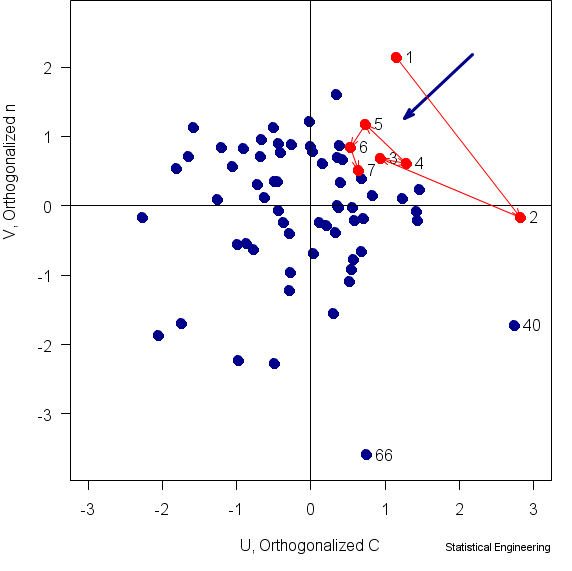Predictions of conditions causing early failure, based on the demonstrably false premise of a “Most Probable Point,” are most probably wrong.
Why the “Most Probable Point” Isn’t, Part 2.
The concept of a “Most Probable Point” was demonstrated to be a fiction in MMP, Part 1.
Ah Ha!!! I can hear the True Believers chorus. You didn’t sprinkle the magic Pixie Dust of orthogonalization on your data!
Orthogonalizing the data doesn’t rescue the failed concept, as is illustrated in the following figure:

The Paris Law parameters C, n for 68 fatigue crack growth specimens tested under nominally identical conditions were transformed to U,V the corresponding orthogonal array, having zero means and zero off-diagonals on the covariance matrix.
So what?
The MPP is a fiction. Early failures do not result from a tiny, point-sized neighborhood of parameter values, even if they have been orthogonalized.
These 68 tests were performed as close to being identical as was humanly possible. If the idea of a Most Probable Point cannot work for something as fundamental as 68 identical tests, tested under identical conditions, from the same heat of material, in the same laboratory, by the same Ph.D. student, how could it possibly work in a more realistic, more challenging situation?
All this reinforces the fact that the mathematical dream of a “most probable point” simply is not borne out by real physical laboratory observations, however disconcerting that may be to a true-believer.
Predictions of conditions causing early failure, based on the demonstrably false premise of a “Most Probable Point,” are most probably wrong.
But Wait! FORM/SORM is about Demand and Capacity! You showed only \(C, n\) and they are both related to Capacity! What about the Demand?
The quick answer is that these tests were all run at the same stress. The demand is constant. This reduces a 3-dimensional probability ellipsoid to the 2-dimensional ellipse shown in Figure 1 earlier. But if you insist on further demonstration, please read on …

